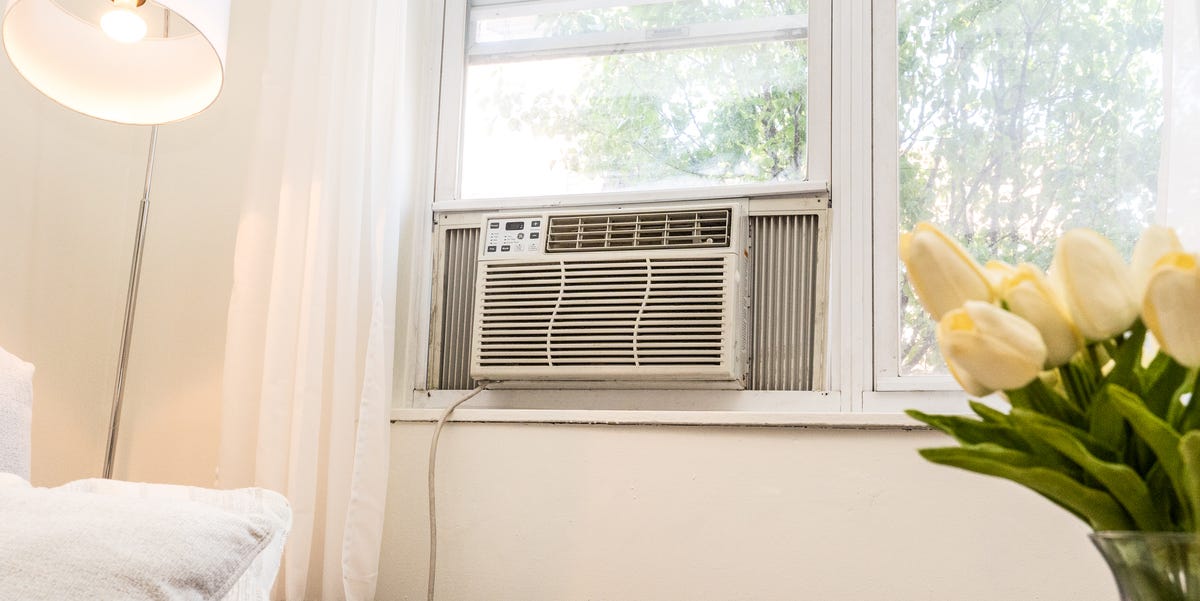The 6 Best Window Air Conditioners for 2025

Sometimes opening a window or running a fan is simply not enough to keep you cool in the heat. And this is to say nothing of the misery of trying to sleep in a stuffy, hot room. If you don’t have central air at home, the best way to combat sweltering days and nights is with a window air conditioner. Window air conditioners remove hot and humid indoor air by drawing it inside the unit where it’s converted to cool, dry air that gets blown into the room while heat is dispersed outside. Finding a unit that satisfies your cooling needs—and fits your window—that won’t jack up your electric bill requires some research. We tested a range (and included promising models we haven’t tried yet) to find the best window air conditioners out there and help you select the right appliance. Need other cooling solutions? Check out our picks for the best air conditioners and portable air conditioners.The Best Window Air ConditionersBest Overall: LG Dual Inverter Smart Window Air ConditionerBest Value: Frigidaire FFRA051WAE Window Air ConditionerQuietest: Midea MAW12V1QWT Window Air ConditionerBest for Medium-Sized Rooms: LG LW6017R Window Air ConditionerBest Features: Windmill Smart Inverter Window Air Conditioner How Do Window Air Conditioners Work? Window air conditioners use motor-driven fans to pull hot, moist indoor air over a metal tube coil with cold refrigerant gas inside. The heat energy in the room passes through the metal coil into the cold refrigerant inside. Then the appliance’s compressor draws the heated gas to a coil on the back of the appliance, converting the gas into a liquid. Another motor-driven fan blows outdoor air over this hot, liquid-filled coil and discharges the heat to the outdoors. In exchange, you get cool and dry air pumped inside.Equally important in the cooling process is dehumidification. In the summer, there’s a lot of moisture vapor suspended in the air, and in order for you to feel more comfortable, the air conditioner has to remove it.Thomas HenggeThe moisture vapor in the indoor air condenses on the coil’s cold surface. This water drips down to the back of the appliance and runs out through a drain. Alternatively, the fan on the back picks it up and throws it against the hot coil, where it’s converted back to moisture vapor and discharged outside with the hot air. The cooling process is identical among various window air conditioners. However, the appliance’s cooling capacity, features, and controls differ. For advice on how to clean your window air conditioner, check out our deep dive on the topic. How many BTUs do you need?Look for a window air conditioner with a high Combined Energy-Efficiency Ratio rating. CEER is the efficiency rating that applies to window air conditioners. (Note: This is different from SEER, or Seasonal Energy-Efficiency Ratio, which applies to heat pumps and central a/c systems.) The higher the rating the better.The CEER number expresses the ratio of cooling capacity, measured in British Thermal Units (BTUs), relative to how much electricity the appliance uses to cool the space. It includes the appliance’s efficiency when the compressor is energized and running and when it’s not running, in standby mode. A few air conditioners still retain the older (but still valid) EER efficiency number, and the same rule applies—a high EER is better than a low one The window air conditioner you choose must have roughly 20 BTUs of cooling per square foot of room space. Measure the square feet of the room’s floor and multiply that by 20. For example, a 20-by-15-foot room would require a small, 6,000-BTU air conditioner.Do you want simple or smart controls?Window air conditioners are no different from other appliances regarding programming and controls. Controls range from simple knobs to buttons to touch-activated electronic panels similar to microwaves or washing machines. Some window air conditioners have handheld remotes or employ smartphone apps for controls. More expensive window air conditioners are typically more fully featured. Some are equipped with a dehumidification setting for dealing with extra moist air, a heater, a fan to use without cooling, and timers that allow you to slowly back off the cooling output at night as you fall asleep. Some smarter appliances can even ramp back up, cooling your room again toward dawn. Others have smartphone features that allow you to control your unit from afar and geofencing that automatically turns the unit on when your phone comes within a radius of your home.How We Selected and TestedWe surveyed the market for units with great construction quality, energy efficiency, noise reduction, simplicity of use, convenience, ease of maintenance, and versatility. We tested several of the window air conditioners we recommend by installing them in a 1,200-cubic-foot space with a high ceiling, a small two-bedroom apartment, and a bedroom/office in a one bedroom apartment. We ran each appliance at various settings and used an infrared thermometer to measure the AC’s effect on its surroundings, such as walls and nearby objects. Next, we measured how far away the cooling breeze could be felt, known as throw. Most models we recommend throw cool air six to eight feet. For the appliances we haven’t tested, we consulted engineers at the manufacturers, scoured the specs, noted features, and considered user reviews and compared that with our extensive experience using and installing window air conditioners. Dual Inverter Smart Window Air Conditioner This LG uses a multi-speed compressor to control cooling, speeding up and slowing down to maintain the desired temperature. While most window units don’t use this method, we found the adaptable dual-inverter design from LG a great way to keep the room temp steady.It’s pretty quiet, too, with a sleep mode that quiets the motor at night so you can get better rest. This window unit won best overall compared to all of the other window and portable units we tested because of its ease of use, efficiency, and quiet operation.Best of all, LG includes insulation for keeping cold air in and warm air out—a notorious drawback of most window units. FFRA051WAE Window Air Conditioner The Frigidaire is a low-effort, high-efficiency air conditioner designed to cool off a small, stuffy space quick.It has a simple two-knob control system. The top knob controls the cooling setting, the bottom knob controls fan speed, and you have the option to run the fan with or without cooling. The appliance’s thermostat cycles the air conditioner on and off to keep the temperature within range based on the temperature you set with the top knob. There’s no smart functionality so it can only be controlled from the knobs. Still, it’s an efficient window unit that won’t hurt your wallet and its washable filter saves you money on having to buy replacements. MAW12V1QWT Window Air Conditioner The whisper-quiet operation of this quality AC unit isn’t it’s best feature, and that’s saying a lot since this was the quietest of the lot we tested. Even better than its hushed noise level is the U-shaped mounting, which lets you fully close your window between indoor and outdoor sections of the unit.It’s the sort of design that makes you ask why all window AC units aren’t like this—but alas, this unit does require a special mounting bracket to work correctly.This inverter compressor AC unit uses multi-speed, like the LG we deemed best overall, but this has automatically swinging louvers to distribute air even better. Window Air Conditioner This high-performance, 6,000-BTU LG window air conditioner is designed to cool medium spaces quickly, ideal for rooms up to 10 by 25 feet. Its many features include a 24-hour on/off timer, a full-function remote control, three cooling speeds, three fan speeds, and an auto reset that turns the unit back on once power is restored after a power outage.When indoor air humidity is high, this air conditioner has powerful dehumidifying abilities to keep you from that sticky feeling. Smart Inverter Window Air Conditioner Windmill’s unit comes equipped with the features you’d expect from its modern design—Wi-Fi and smart home-compatibility, ease of installation—with the added convenience of built-in voice command. Instead of shooting air straight out, its vents are on top of the unit to shoot up and outward for better circulation overall. It’s also one of the quietest models we tested so it’s great for light sleepers. It includes insulated wings though they aren’t on par with the quality of the unit and we added some extra insulation. The app is also very intuitive. Like the unit itself, the app is well thought-out and well designed making it easy to set the Windmill to eco mode or set the fan and cooling settings. Air Conditioner The July unit is sleek, customizable, and can be setup in less than 20 minutes. It comes with a bracket, with insulating wings included, that screws into the window. After that’s installed, you simply slide the air conditioner in and it’s ready to go. The control panel is located on top of the unit rather than on the front so it’s more comfortable to operate than having to crouch down to see which button does what—a minor but appreciated design note. You can also control the unit from the straightforward app to change modes, fan speed, and schedule automatic on and off time. There’s a remote control included so you can choose which to use. We used the app to turn on the A/C before getting home but used the remote when actually in the apartment.The unit is quiet on its lowest setting and on high sounds like a dryer behind a closed door—noticeable at first, but muffled enough that you don’t have to turn up the T.V. volume. Another huge plus is that it fits smaller windows. We installed it in a very small corner window of a living room that couldn’t house pretty much any other standard sized unit. The July fit perfectly without the insulating wings.


















